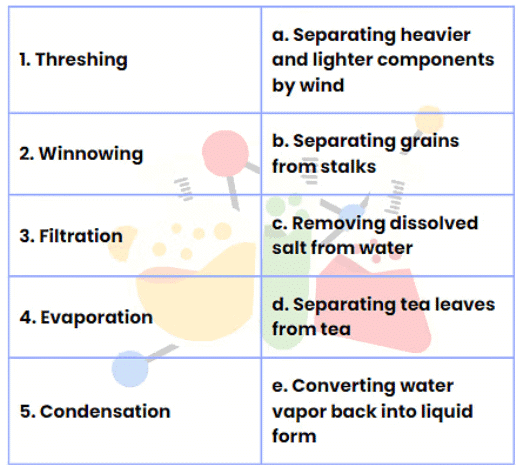Worksheet: Methods of Separation in Everyday Life - 2 | Worksheets with Solutions for Class 6 PDF Download
| Table of contents |

|
| True or False |

|
| Match the Following |

|
| Fill in the Blanks |

|
| Assertion and Reason Questions |

|
| Answer the following |

|
True or False
(i) The property used in separating a mixture of two solids by winnowing is the difference in weight.
(ii) A mixture of milk and water can be separated by filtration.
(iii) A mixture of powdered salt and sugar can be separated by the process of winnowing.
(iv) Separation of sugar from tea can be done with filtration.
(v) Grain and husk can be separated with the process of decantation.
(vi) Sieving is used when the components of the mixture are of different sizes.
(vii) The method of filtration is also used in the process of preparing cottage cheese in homes.
(viii) Hand-picking can be used to separate cashew nuts from a mixture of almonds and cashew nuts.
Match the Following

Fill in the Blanks
(i) The process of separating a liquid from solid sediment is called .
(ii) The method of separating seeds of paddy from its stalks is called .
(iii) When milk, cooled after boiling, is poured onto a piece of cloth the cream (malai) is left behind on it. This process of separating cream from milk is an example of .
(iv) Salt is obtained from seawater by the process of .
(v) is used to remove impurities and bran from the flour.
(vi) We see water drops under the plate that has been used to cover a container containing milk that has just been boiled. This is due to the process of .
Assertion and Reason Questions
Q4: Assertion (A): The process of settling of heavier insoluble particles from a suspension of a substance in water is known as decantation.
Reason (R): Decantation process, along with sedimentation, is used to get clear water from muddy water.
(a) Both A and R are true, and R is the correct explanation of A.
(b) Both A and R are true, but R is not the correct explanation of A.
(c) A is true, but R is false.
(d) A is false, but R is true.
Answer the following
Q5: Write any two methods used for the separation of substances.
Q6: How can we separate sand from water?
Q7: Which method would you prefer to separate a solid dissolved in a liquid?
Q8: The Filtration method is used to separate tea leaves from prepared tea. Which other method can be used?
Q9: List various methods of separation of components from their mixtures.
Q10: The process of adding alum to water to fasten sedimentation is called loading. Why has this name been given to the process?
Q11: Why is sieving not used to separate very small stones from rice grains?
Q12: What is winnowing? Where is it used?
Q13: Why do we separate substances?
Q14: How will you separate husk or dirt particles from a given sample of pulses before cooking?
You can access the solutions to this worksheet here.
FAQs on Worksheet: Methods of Separation in Everyday Life - 2 - Worksheets with Solutions for Class 6
| 1. What are some common methods of separation used in everyday life? |  |
| 2. How does filtration work in separating mixtures? |  |
| 3. What is the importance of separation techniques in daily life? |  |
| 4. Can you explain the process of evaporation and its application? |  |
| 5. What role does distillation play in the separation of liquids? |  |




















